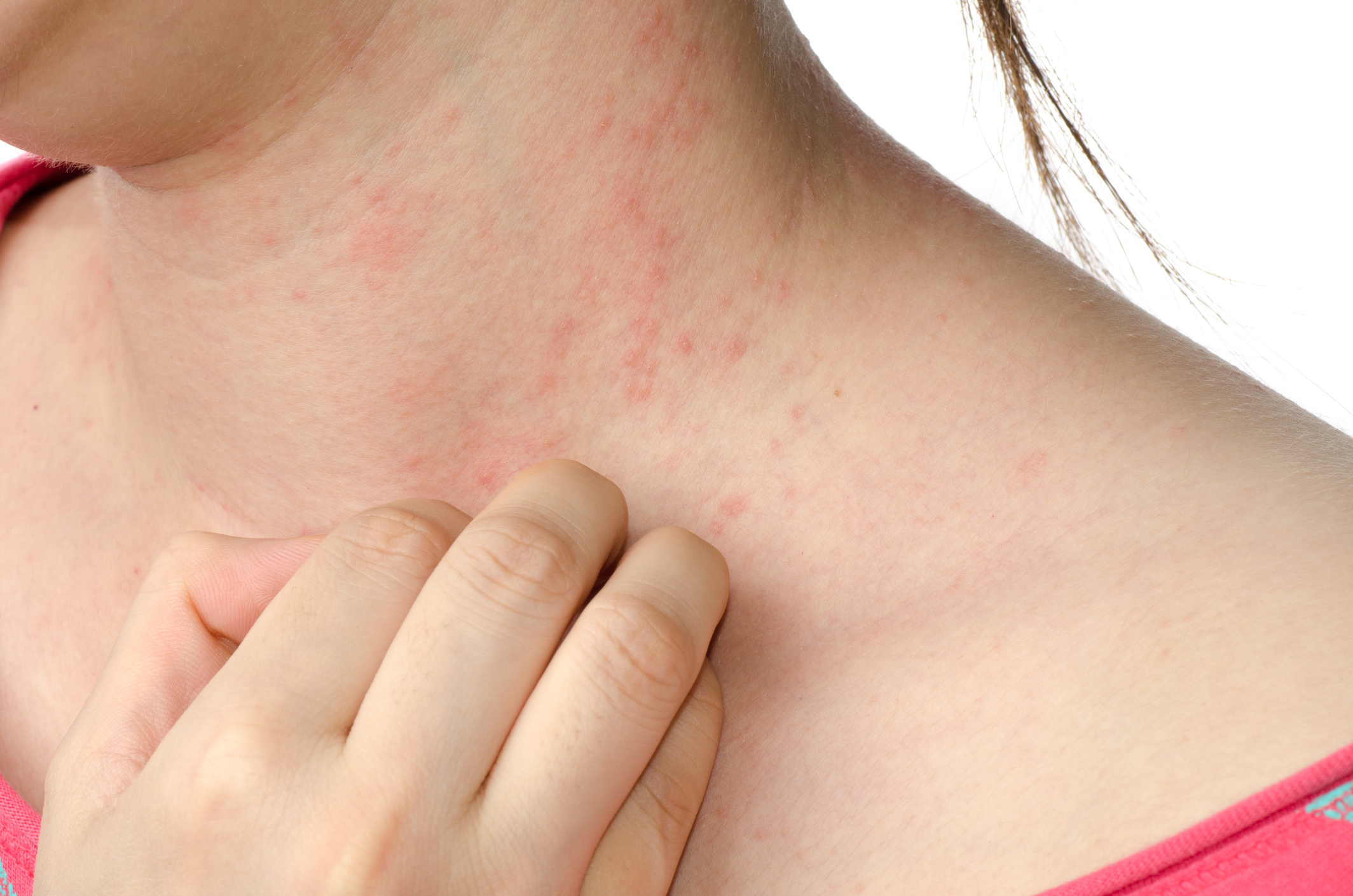Common condition
Eczema & Dermatitis
Eczema is a type of dermatitis (inflammation of the skin) that causes patches of skin to become red and itchy. These conditions are often caused by various allergens, such as pollen, dust, food, or chemicals. There are various treatment options for Eczema and dermatitis - ranging from steroid creams and ointments, bath additives, or emollients.
Eczema & Dermatitis Advice
Eczema - What is it?
Eczema affects over 1 million people in the UK, and it is a long-term condition that is sometimes referred to as dermatitis. This condition can range from mild to more severe, mild cases can cause the skin to become dry, itchy, red, and scaly. Severe cases of dermatitis can cause weeping, bleeding, and crusting.
Eczema is very common among children - affecting roughly one out of every five children. This condition occurs less frequently in adults but is still quite common. Like other health conditions, many children will simply grow out of their eczema.
Your skin is designed to act as a barrier against potential infections and other harmful elements in the environment. However, the skin is actually composed of three layers - the epidermis (outer layer), the dermis (an elastic middle layer), and the hypodermis (a fattier inner layer).
Commonly, someone suffers from eczema because they don’t produce sufficient fats or natural oils to maintain the health of these different skin layers. This also causes the skin to retain less water, which causes it to appear dry and cracked. Unfortunately, this dryness leads to openings that allow irritants to penetrate deeper into the skin. These irritants can cause itchiness, leading to scratching, which then leads to skin splitting open and increasing the likelihood of an infection.
Eczema - The most common kinds
Different kinds of eczema also have different effects on the sufferer - the most common are the following:
Atopic Eczema
This is the most common kind of eczema we know of. It usually causes red bumps and blisters underneath the surface of the skin. It’s most likely to affect children but it’s also seen in fully grown adults. Children who have this kind of eczema will likely grow out of it. There is a heredity component to atopic eczema, but you’re children are not guaranteed to get it if you or your siblings had it.
Atopic eczema is known to affect the armpits, breasts, nipples, wrists, fingers, neck, and eyelids. It’s usually dry and red and flare-ups can appear in patches throughout the body. These flare-ups are most likely due to a trigger of some kind, such as stress, soap, pollens, overheating, dust mites, and clothing.
Contact Dermatitis
This type of dermatitis affects around 20 percent of the general population. This makes it one of the most common types of work-related skin diseases. This form of eczema usually causes red, itchy, and scaly skin patches that can cause a stinging or burning sensation. Contact dermatitis is usually found in the hands and knuckles but it can affect any area of skin on the body.
Contact dermatitis is usually caused by coming into contact with irritants and substances that can physically damage the skin. These can irritants can be in the forms of soaps, detergents, solvents, perfumes, and even antiseptics. The other major cause of contact dermatitis is allergens - which cause the body’s immune system to damage the skin.
Seborrhoeic Eczema
This form of eczema mainly targets areas of skin that are near sebaceous glands (these are glands that produce sebum, which acts as a lubricating substance for hair and skin). The most common places for seborrhoeic eczema to appear are the scalp and the nose, and the most common symptom is either a red rash or dandruff (if on the scalp).
The exact cause of this type of eczema is not fully understood. There is some interaction with a yeast called pityrosporum ovale and this condition - as this specific type of yeast is found in the skin of people suffering from seborrhoeic eczema. However, what’s not understood is if the yeast is a cause or effect.
Rarer kinds of Eczema
- Discoid eczema - This is a common form of eczema found in adults with dry skin. It forms disc or coin-shaped patches on the affected skin. This kind of eczema is usually found on the lower legs, forearms, or trunk. The exact cause is not completely known.
- Gravitational eczema - Also known as varicose or stasis dermatitis. Poor circulation, varicose veins, and blood clots all increase the likelihood of this condition. This eczema often appears as dark or brown patches under the skin.
- Asteatotic eczema - This form of dermatitis usually only affects the elderly, and usually forms patches of red and pink paving that almost look like it’s etched onto the skin. Those affected usually experience soreness and itching - most often on the shins. Low humidity and low levels of natural oils are believed to be the cause of this condition.
- Pompholyx eczema - This form of eczema is usually found as blistering in the hands and feet. These blisters will usually be inflamed and feel very itchy - they are also prone to breaking and weeping with skin peeling as they dry out.
Eczema - How is it diagnosed?
Eczema is not hard for a doctor or GP to diagnose. They will visually examine the affected areas and ask you a few questions about your medical history. They will usually ask when symptoms appeared and if your job requires you to handle potential irritants. In most cases of eczema, symptoms will be mild and are not difficult to keep under control.
For more severe cases of eczema - you will be referred to a dermatologist, who will be able to tailor your treatment to your specific condition.
Eczema - Controlling and treating it
There are two main types of treatment for eczema; emollients and steroid-based creams.
Emollients (moisturizers) can be used several times a day to help support skin health.
Steroid-based creams are used in the short term to control flare-ups.
Emollients
Emollients moisturize your skin and help you feel less itchy. It’s vitally important in treating any kind of eczema to keep the skin as healthy as possible. Applying emollients fairly often (repeatedly, thought the day) is a fantastic way of supporting your skin. Often, emollients will control most cases of mild to moderate eczema.
Emollients can come in the form of ointments, creams, and lotions.
Corticosteroids
These are topical (applied to the skin) creams that contain some form of steroid treatment. They should be used as directed by a doctor or medical professional and they are an excellent treatment option for even the most severe forms of eczema. These creams are applied directly to the skin and they will work to reduce inflammation - most of the time these creams will only need to be applied once a day.
Eczema - Preventing flare-ups
There are several methods of reducing the likelihood of eczema flare-ups:
- Apply emollients regularly (around four times a day).
- Avoid very hot baths or showers.
- Avoid harsher soaps.
- Dry yourself with a cotton-based towel as it will remove moisture from the skin and allow topical creams to work more effectively.
- Use a humidifier in the winter months.
- If you suffer from contact dermatitis - try your best to avoid anything that can trigger your condition.
Eczema - Non-prescription alternatives
- Antihistamines (these will ease itching)
- Over-the-counter emollients and moisturizing creams
- Cotton gloves (these will reduce itching, which can make things worse)
- Baths and shower gels (so long as they don’t contain chemicals that trigger your condition)
Frequently Asked Questions
No, we do not sell medication directly. We offer a variety of solutions via our partners. You'll be taken to their store directly when you purchase.
Additional information




